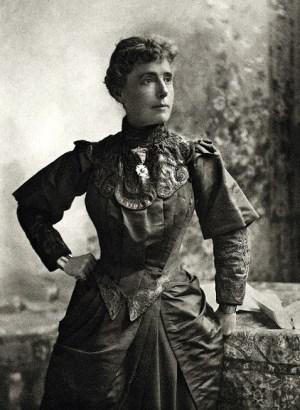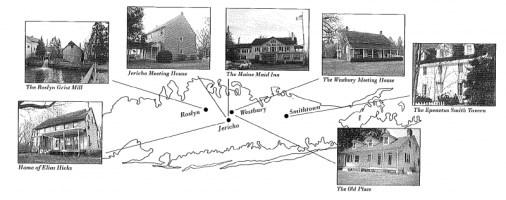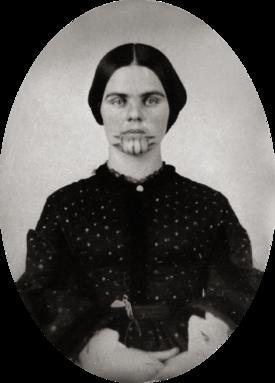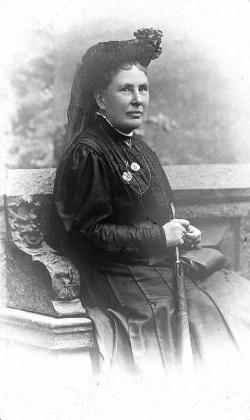Field Hospitals at the Battle of Antietam During the Battle of Antietam, farms owned by Joseph, Samuel, Alfred and John Poffenberger were used and abused by military personnel. The families passed down stories of hiding livestock and household valuables from the hordes of soldiers who were plundering farms and homes. A teenager at the time, Otho Poffenberger, son of John Poffenberger, fled with other members of his family to the safety of Shepherdstown, four miles away in what is now West Virginia. Image: Joseph Poffenberger Farm Layout Image Credit: South From the North Woods Joseph Poffenberger Farm Joseph Poffenberger purchased this farm from his father-in-law in 1851. On the afternoon of September 16, 1862, the nearly 8,600 men of General…

Kate Field
One of the First American Women Journalists Kate Field was one of the first American celebrity journalists. A literary and cultural sensation, she wrote for several prestigious newspapers, such as the Boston Post, Chicago Tribune, and New York Herald. She was an intelligent and independent woman, an outspoken advocate for the rights of black Americans and founder of the first woman’s club in America. Early Years Mary Katherine Kate Field was born October 1, 1838 in St. Louis, Missouri, the daughter of an actor father and a Philadelphia Quaker mother. Kate lived with her millionaire aunt and uncle, Mr. and Mrs. Milton H. Sanford, and they financed her education in New England, and then in England. They also traveled throughout…
Mary Putnam Jacobi
Pioneer for Women in the Medical Professions Mary Putnam Jacobi was a prominent physician, author, scientist, activist, educator, and perhaps most importantly, a staunch advocate of women’s right to seek medical education and training. Men in medicine claimed that a medical education would make women physically ill, and that women physicians endangered their profession. Jacobi worked to prove them wrong and argued that it was social restrictions that threatened female health. Image: Mary Corinna Putnam as a medical student, 1860s Jacobi was the most significant woman physician of her era and an outspoken advocate for women’s rights, rising to national prominence in the 1870s. She was a harsh critic of the exclusion of women from the professions, and a social…

Underground Railroad on Long Island
Quakers Ran the Underground Railroad In the seventeenth century, to the Englishmen who first settled Long Island, slavery was an accepted way of providing the labor force needed for agriculture and a comfortable life. After the arrival of the Quakers in the eighteenth century, attitudes were changed and the Underground Railroad began guiding slaves to freedom. Image: Map of Long Island towns on the Underground Railroad Long Island Stretching east-northeast from New York Harbor into the Atlantic Ocean, Long Island comprises four counties: Kings County (Brooklyn) and Queens County (Queens) in the west, then Nassau County and Suffolk County to the east. The Island is 118 miles long from east to west and about 20 miles at its widest point,…
Josephine Sophia White Griffing
Activist in the Abolitionist and Women’s Rights Movements Image: Family of Slaves Washington, DC, 1861 Josephine Sophia White Griffing was a social reform activist who campaigned for the abolition of slavery and women’s rights. In 1864, she moved to our nation’s capital to help the newly freed slaves who were streaming into the capital by the thousands. Griffing worked primarily as an agent for the Freedmen’s Bureau in Washington, DC. Early Years Josephine White was born December 18, 1814 in Hebron, Connecticut into a prominent New England family. Her father Joseph White Jr. served as a representative in the state legislature; her mother was sister of portrait artist Samuel Lovett Waldo. Little is known of Josephine’s childhood, and there are…

Olive Oatman
Indian Captive in Present-Day California Olive Oatman was a fourteen-year-old girl whose family was killed in 1851 in present-day Arizona by Native Americans, possibly the Yavapai, who captured and enslaved Olive and her sister. A year later Mojave Indians adopted the two girls. After four years with the Mojave, during which time her sister died of starvation, Oatman returned to white society. Her story has been told, retold and embellished so many times – in the media and in her own memoir and speeches – that the truth is not easy to discern. Image: Olive Oatman after she was ransomed Mojave blue cactus ink tattoo on her chin: Five vertical lines with triangles set at right angles Credit: Arizona Historical…
Josephine St. Pierre Ruffin
Journalist and Founder of African American Women’s Clubs Josephine St. Pierre Ruffin was an African American leader, a publisher, journalist and editor of Women’s Era, the first newspaper published by and for African American women. She was an abolitionist and suffragist, and she is perhaps best remembered for her role in establishing clubs for African American women. Early Years Josephine St. Pierre was born August 31, 1842 in Boston, Massachusetts to John St. Pierre, a French and African man from Martinique, and Elizabeth Matilda Menhenick, a white woman from Cornwall, England. Her father was a very successful tailor in Boston and her family was a part of Boston society. Josephine received her education at public schools in Charlestown and Salem,…

Anne Whitney
19th Century Sculptor and Poet Anne Whitney was a poet and sculptor who fought to become an artist in a society that did not readily accept female sculptors; sculpture was considered a masculine art form. As with so many of the first 19th century women sculptors, Whitney was a member of a wealthy and supportive family, who helped her financially while she developed her natural talents. Image: Anne Whitney (seated) With partner and painter Abby Adeline Manning Early Years Anne Whitney was born September 2, 1821 in Watertown, Massachusetts; she was the daughter of well- to-do farmer Nathaniel Whitney and his wife Sarah Stone Whitney. Her supportive and liberal parents encouraged Anne to develop her artistic talents.
Spotsylvania Court House in the Civil War
Battle of Spotsylvania Court House On May 7, 1864, after two days of brutal fighting failed to produce a victory at The Wilderness, previous Union commanders would have chosen to withdraw behind the Rappahannock River. But General Ulysses S. Grant ordered General George Meade to move around Lee’s right flank and seize the important crossroads at Spotsylvania Court House to the southeast. Image: Bonnie Blue Flag by Don Troiani Mule Shoe, Spotsylvania Court House, May 12, 1864 With Federals pouring over the entrenchments, Confederate formations are in disarray. To encourage his comrades, Private Tisdale Stepp of the 14th North Carolina begins singing the stirring Southern anthem Bonnie Blue Flag and others soon join him. Elements of General Robert E. Lee‘s…

Alice Cunningham Fletcher
Ethnologist, Anthropologist and Social Scientist Alice Cunningham Fletcher was a pioneer in the science of ethnology, living among American Indians while studying and documenting their culture. Fletcher was a leader in the movement to bring Native Americans into the mainstream of white society, but some of her ideas proved to be detrimental to the Indians. Early Years Alice Cunningham Fletcher was born in Havana, Cuba March 15, 1838 after her family traveled there in an effort to improve her father’s health. Both of her parents were from wealthy New England families – her father was a New York lawyer and her mother came from a prominent Boston business family. Little documentation of her early life remains. After her father died…